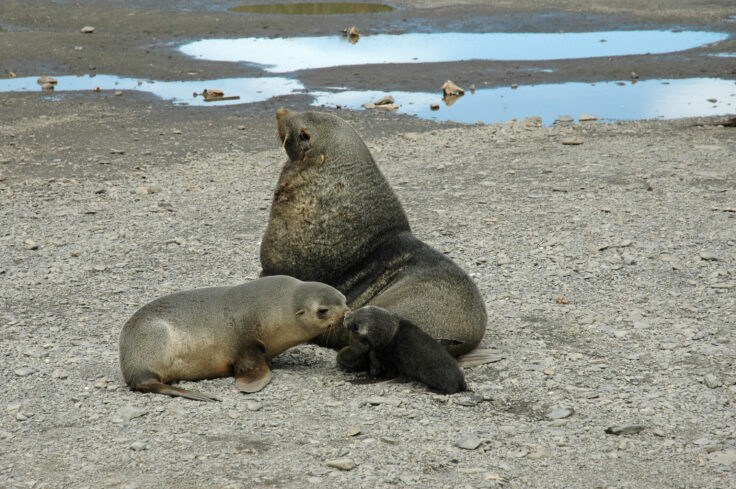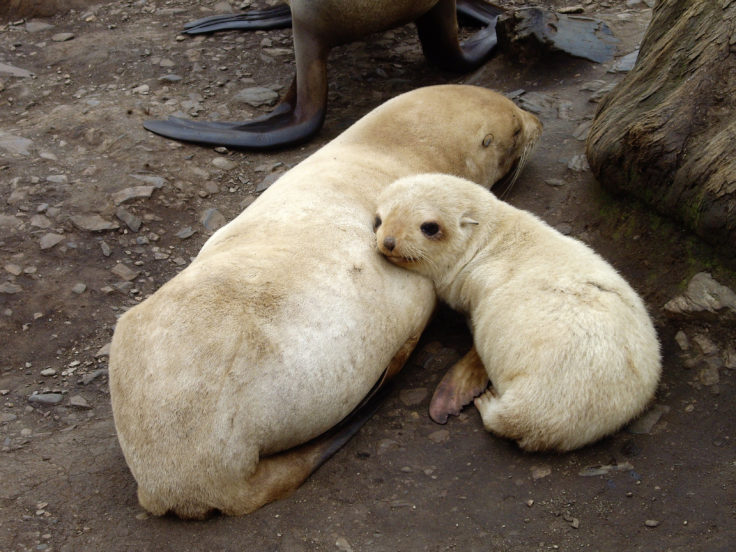PRESS RELEASE: Scent matters to fur seals
Antarctic fur seals have unique ‘scent profile’ to recognise their pups
Researchers studying Antarctic fur seals have discovered their scent has a unique ‘profile’ which enables them to recognise their offspring and family members. Until now researchers thought voice recognition was mostly important for finding their young, but now it is proven that scent also plays a crucial part. The results are published this week (Monhttps://www.bas.ac.uk/wp-admin/post-new.php?post_type=news#day 10 August) in the journal the Proceedings of the National Academy of Sciences.
The sense of smell and an animal’s scent is an important means of communication in the animal kingdom. This applies not only to social interactions, but also to territorial behaviour, recognising kin and when selecting a mate. However, understanding communication by smell is very challenging because of the mixture of chemicals on an animal’s skin – it may be affected by hormones, the microbial flora, body condition and health, and environmental factors.
A team of scientists from the University of Bielefeld and British Antarctic Survey sampled the skin and fur from dozens of mothers and their pups from two different colonies on the breeding beaches at Bird Island Research Station near the sub Antarctic Island of South Georgia. They found the scent of mothers and pups had similar characteristics.

Martin Stoffel, lead author from University of Bielefeld says:
“Our results are surprising for a marine animal that spends more than 80% of its time at sea. They show that fur seal pups smell similar to their mothers as many of the chemicals on their skin are shared and genetically encoded. Also, individuals with high genetic variability have a more complex scent profile, meaning they have a greater number of substances on their skin. This could be significant when it comes to choosing a mate, because genetic diversity is often positively correlated with survival.”
Antarctic fur seals give birth to a single pup and nurse it for approximately four months until weaning. During this time, mothers undertake five- to ten-day foraging trips at sea to find food and produce milk that they deliver to their pups over a one- to three-day period ashore. When they return from the sea, they need to find their pups.
Co-author Dr Jaume Forcada from British Antarctic Survey says:
“In heavily populated breeding beaches such as those of Bird Island, where thousands of pups are born, fur seal mothers need to find their hungry offspring when they return from long foraging trips at sea. This study has shown us that scent is critical to this process, especially for bonding.”
Co-author Dr Barbara Caspers specialises in communication through smell at Bielefeld University. She says:

“The idea that scent signal relatedness has been around for a long time, but this has not been chemically proven until now. In evolutionary history, the sense of smell is the first sense. There is reason to believe the mechanisms are similar across the animal kingdom and not just fur seals.”
According to co-author Dr Joe Hoffman, scent is multidimensional. He says:
“The scent profiles are very complicated – only a fraction of the substances encode relatedness. Nevertheless, the fact that relatedness is genetically encoded could mean that related fur seals are able to recognise each other through odour and this in turn could help prevent inbreeding and preserve genetic diversity.”
The study provides more information about the behaviour of Antarctic fur seals as part of a 30-year study monitoring their populations on the island of South Georgia. Fur seal populations on the island of South Georgia were decimated by hunting around 100 years ago. Scientists are monitoring them to observe the impacts of climate change and to collect information to ensure the fishery is managed sustainably and includes measures to protect fur seals and other marine mammals from fishing activity.
Issued jointly by the Press Offices at University of Bielefeld and British Antarctic Survey.
Press office contacts:
Ulrike Prange, University of Bielefeld, tel: +49 521 106 4199; email: Ulrike.prange@uni-bielefeld.de
Paul Seagrove, British Antarctic Survey, tel: +44 (0)1223 221 414; mobile: +44 (0)7736 921 693; email: psea@bas.ac.uk
Video of Antarctic fur seals is available from the ftp site here: ftp://ftp.nerc-bas.ac.uk/pub/photo/_BAS_Video_composite_tapes/wildlife/
To download, do not use an FTP Client, simply open the above link with any standard web browser (Firefox, IE, Safari etc) and right click on the filename to begin the download
Authors:
M Stoffel, Bielefeld University, tel: 0049-176-28043630; email: martin.stoffel@uni-bielefeld.de
Dr Joseph Ivan Hoffman, Bielefeld University, tel: +49 (0)521 106 2711; email: j_i_hoffman@hotmail.com
Dr Jaume Forcada, British Antarctic Survey, please contact the BAS Press Office as above.
NOTES FOR EDITORS
The paper Chemical fingerprints encode mother-offspring similarity, colony membership, relatedness and genetic quality in fur seals by Stoffel, M. A.1,2, Caspers, B.A.1, Forcada, J.3, Giannakara, A.1, Baier, M.C.1, Eberhart-Phillips, L.J.1, Müller, C.4 & Hoffman, J.I.1 is published this week (Monday 10 August) in the Proceedings of the National Academy of Sciences.
Funding
This work contributes to the projects ‘Long Term Monitoring and Survey’ and ‘Ecosystems’ of the British Antarctic Survey, Natural Environment Research Council, core funded science programme Polar Science for Planet Earth. The genetic work was supported by a Marie Curie FP7-Reintegration-Grant within the 7th European Community Framework Programme (PCIG-GA-2011-303618) and a Deutsche Forschungsgemeinschaft standard grant (HO 5122/3-1) awarded to Joseph Ivan Hoffman.
Bielefeld University was founded in 1969 with an explicit research assignment and a mission to provide high-quality research-oriented teaching. Today it encompasses 13 faculties covering a broad spectrum of disciplines in the humanities, natural sciences, social sciences, and technology. With about 22,000 students in 108 degree courses and about 2,750 staff members (including 264 professors and lecturers as well as 1,380 academic staff) it is one of Germany’s medium-sized universities. The research profile of Bielefeld University is oriented to big issues relevant to science and society, primarily at the productive interfaces between disciplines. The University also distinguishes itself in its teaching through its specific profile that is based on dense networks across disciplines. For more information visit www.uni-bielefeld.de
British Antarctic Survey (BAS), an institute of the Natural Environment Research Council (NERC), delivers and enables world-leading interdisciplinary research in the Polar Regions. Its skilled science and support staff based in Cambridge, Antarctica and the Arctic, work together to deliver research that uses the Polar Regions to advance our understanding of Earth as a sustainable planet. Through its extensive logistic capability and know-how BAS facilitates access for the British and international science community to the UK polar research operation. Numerous national and international collaborations, combined with an excellent infrastructure help sustain a world leading position for the UK in Antarctic affairs. For more information visit www.bas.ac.uk